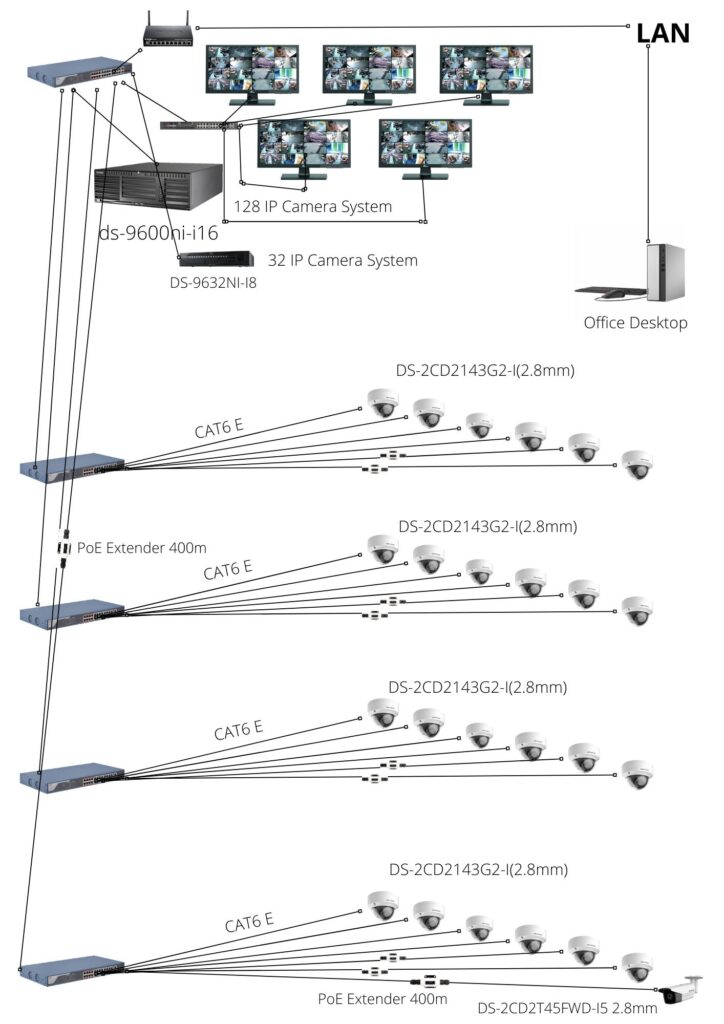PoE technology is a way to transmit power and data over Ethernet cable. It can be used for powering up a network device such as a CCTV camera. The PoE protocol was developed by Cisco in 1998 and has become an industry standard.
Running cable over long distances is a significant challenge with PoE. Many CCTV installers struggle with installing PoE cameras with extensive cable runs. Let’s have a look at some methods for extending the PoE cable over a longer distance.

Power over Ethernet (PoE):
Power over Ethernet (PoE) transmits power and data to the edge device through a single Ethernet cable. It eliminates the need for an additional power cord to the edge device. The PoE system not only simplifies cable wiring but also saves time and money during installation.
After all, IP edge devices such as IP cameras, access points, and VoIP require power, and PoE can be the best option.
PoE NVR is a network video recorder that contains a PoE Switch, making it the ideal solution for home CCTV.
PoE Splitter:
If your edge device lacks the PoE function for power regulation and the power handshake, you can add a PoE splitter before the edge device. The POE splitter can receive PoE and separate power from data while regulating power output.
How do you extend a PoE system beyond 100 metres?
PoE Switch and CCTV mode:
Some PoE switches feature CCTV mode, which offers 250 metres of PoE while in CCTV mode. The function is solely intended for IP cameras and makes a trade-off between bandwidth and distance.
Disadvantages of CCTV mode:
- When CCTV mode is on, the bandwidth is reduced to 10mbps. It can still hold one 1080p IP camera. However, as the resolution increases, the bandwidth will become constrained.
- It can be challenging when multiple users attempt to access the same camera simultaneously.
- The bandwidth is twice when two video streams come from the same IP camera.
PoE Extender:
A PoE extender is the most widely used option of repeating a PoE network. The PoE extender requires a port but does not require an extra power supply device.
The extender may take a tiny amount of power from the back-end PoE Switch and forward the power reset to the edge PoE device. In essence, the PoE extender does not process power but supplies the power handshake. If the edge device does not support standard PoE, the PoE extender will not release any power. The entire PoE system must still meet the IEEE802.3 PoE specification.
Instead of a power handshake, the PoE extender can enhance data. To achieve a 300-meter POE link, daisy chain the second PoE extender to the link. Power loss must also be considered. Technically, we cannot increase the power. Inline power loss increases as the distance grows. It is critical to assess the power consumption of the edge device.
Ultra Distance Distance PoE extender:
The PoE Switch can send 800 metres, but you will need a PoE adapter to return the single, which the PoE adapter does. The 800 metre PoE Switch is for long distance POE applications. Even ordinary cate5/cat6 cable comes in rolls of 300 metres, and you will require three 305m drums to reach 800m using the ethernet coupler. No need for any activated equipment within 800 metres, but a PoE adapter must be installed close to the edge device.
Are you new to installing CCTV? Do you want to learn how to install IP CCTV systems like a professional? Why not enrol in our level 3 CCTV Installation Award? Click here to find out more about how we can help you advance your career.
